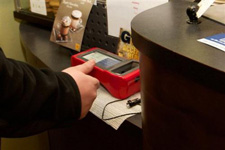print Print...
 (by Amber Hunt, YahooNews) RAPID CITY, S.D. (AP) – Two [stores] on South Dakota’s School of Mines and Technology campus are performing one of the world’s first experiments in Biocryptology – a mix of biometrics (using physical traits for identification) and cryptology (the study of encoding private information). Students at the Rapid City school can buy a bag of potato chips with a machine that non-intrusively detects their hemoglobin to make sure the transaction is legitimate.
(by Amber Hunt, YahooNews) RAPID CITY, S.D. (AP) – Two [stores] on South Dakota’s School of Mines and Technology campus are performing one of the world’s first experiments in Biocryptology – a mix of biometrics (using physical traits for identification) and cryptology (the study of encoding private information). Students at the Rapid City school can buy a bag of potato chips with a machine that non-intrusively detects their hemoglobin to make sure the transaction is legitimate.
Researchers figure their technology would provide a critical safeguard against a morbid scenario sometimes found in spy movies in which a thief removes someone else’s finger to fool the scanner.
On a recent Friday, mechanical engineering major Bernard Keeler handed a Red Bull to a cashier in the Miner’s Shack campus shop, typed his birthdate into a pay pad and swiped his finger. Within seconds, the machine had identified his print and checked that blood was pulsing beneath it, allowing him to make the buy. Afterward, Keeler proudly showed off the receipt he was sent via email on his smartphone.
Fingerprint technology isn’t new, nor is the general concept of using biometrics as a way to pay for goods. But it’s the extra layer of protection – that deeper check to ensure the finger has a pulse – that researchers say sets this technology apart from already-existing digital fingerprint scans, which are used mostly for criminal background checks.
Al Maas, president of Nexus USA – a subsidiary of Spanish-based Hanscan Indentity Management, which patented the technology – acknowledged South Dakota might seem an unlikely locale to test it, but to him, it was a perfect fit.
“I said, if it flies here in the conservative Midwest, it’s going to go anywhere,” Maas said.
Maas grew up near Madison, S.D., and wanted his home state to be the technology’s guinea pig. He convinced Hanscan owner Klaas Zwart that the 2,400-student Mines campus should be used as the starter location.
The students all major in mechanical engineering or hard sciences, which means they’re naturally technologically inclined, said Joseph Wright, the school’s associate vice president for research-economic development. “South Dakota is a place where people take risks. We’re very entrepreneurial,” Wright said.
After Maas and Zwart introduced the idea to students this winter, about 50 stepped forward to take part in the pilot. “I really wanted to be part of what’s new and see if I could help improve what they already have,” said Phillip Clemen, 19, a mechanical engineering student.
Robert Siciliano, a security expert with McAfee, Inc., minimized potential privacy concerns. “We are hell bent on privacy issues here in the U.S. We get all up in arms when someone talks about scanning us or recording our information, but then we’ll throw up everything about us on Facebook and give up all of our personal information for 10 percent off at a shoe store for instant credit,” he said.
Jay Stanley, senior policy analyst with the American Civil Liberties Union, said fingerprint technology on its own raises security issues, but he called “liveness detection” a step in the right direction. “Any security measure can be defeated; it’s a question of making it harder,” he said.
The key to keeping biometric identification from becoming Big Brother-like is to make it voluntary and ensure that the information scanned is used exactly as promised, Stanley said.
Brian Wiles, a Miles mechanical engineering major, said it’s exciting to be beta testing technology that could soon be worldwide. “There was some hesitation, but the fact that it’s the first in the world – that’s the whole point of this school,” said Wiles, 22. “We’re innovators.”
By Associated Press at YahooNews.com. Reprinted here for educational purposes only. Visit news.yahoo.com/sd-college-tests-fingerprint-purchasing-technology-083127597.html for the original post.
Questions
1. Define the following terms used in the article:
- biometrics
- cryptology
- Biocryptology
2. What is unique about Hanscan’s Biocryptology? (How is it different from regular biometric technology?)
3. Why did Al Maas, president of Nexus USA, want Hanscan to test its Biocryptology technology in South Dakota?
4. a) How many students attend SD’s Schools of Mines and Technology?
b) What percent of the student population chose to participate in the Biocryptology testing?
c) Are you surprised that the number wasn’t higher or lower? Explain your answer.
5. Which point of view does the reporter take on the the use of Biocryptology? Give evidence from the article to support your belief.
6. People opposed to the use of Biocryptology are concerned with privacy issues, and a concern over the possibility of it becoming a “Big Brother” type scenario.
a) Would you be opposed to using Biocryptology for all of your purchases? Explain your answer.
b) At what point is convenience more important to you than privacy?
Resources
Visit Hanscan Identity Management’s website at: hanscan.com/en/how-it-works
Watch Hanscan’s promotional video below. (What do you think: Big Brother/creepy OR progress/convenience?)
Daily “Answers” emails are provided for Daily News Articles, Tuesday’s World Events and Friday’s News Quiz.



